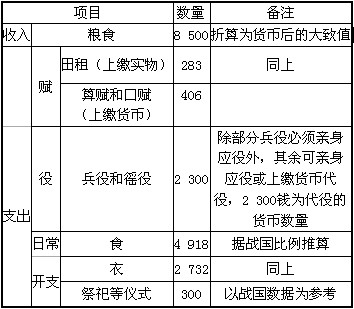阅读材料,结合所学知识回答问题。
材料

西汉农民家庭年收入(粮食)与支出情况表 单位:钱
资料来源:《汉书·食货志》;《〈居延汉简甲乙编〉释文》注:秦汉史料中典型的农民家庭是五口之家。
问题:
(1)计算材料中西汉农民家庭年收入(粮食)与支出的差额。
___________________________________________________________________________________________
(2)据《汉书·食货志》记载,冬天农闲时,农妇常聚集在一起夜织。结合问题(1)的计算结果,简要分析材料中的西汉农民为什么会采用这种耕织结合的经济形式。
___________________________________________________________________________________________
(3)西汉在耕织经济体系下出现了引人注目的商业繁荣现象。根据材料和问题(2)中的信息,简要分析西汉赋役政策和耕织经济形式如何促进商业繁荣。
___________________________________________________________________________________________
(4)有人认为,西汉商业繁荣说明当时已经出现资本主义萌芽。根据问题(3)中的信息和所学知识,判断这一观点是否成立,并说明理由。
___________________________________________________________________________________________
(1)纳钱代役的情况:8500-(283+406+2300+4918+2732+300)=-2439(钱),即亏2439钱;亲身服役的情况:8500-(283+406+4918+2732+300)=-139(钱),即亏139钱。
(2)农民收入不敷支出;衣着消费比重较高;为增加收入,减少支出,农闲纺织。
(3)部分赋役项目征收货币,农民只有将产品投放市场才能换取货币去纳税;农民的剩余产品投放市场,也是商业繁荣的可能原因。
(4)不成立。西汉的商业繁荣部分由赋役政策和耕织经济所推动;西汉的商业与催生资本主义萌芽的商业有本质差别;材料中看不出雇佣关系。
